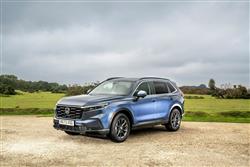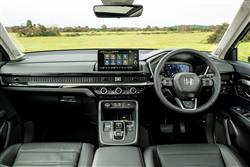Honda CR-V - ABC Leasing
How will you view?
This is a sample, showing 30 seconds of each section.
MORE SENSE & SENSIBILITY(some text hidden)
By Jonathan Crouch
Ten Second Review word count: 59
In a sign of the times, it's now possible to plug your Honda CR-V in. That's because the sixth generation version of this model gains a Plug-in Hybrid powertrain to sell alongside the full-Hybrid e:HEV engine most will prefer. Either way, this car has been completely re-designed for a new era, but it's essential character hasn't changed too much.
Background word count: 208
Honda's CR-V has long been one of the world's strongest selling SUVs. Sometimes, in a market full of more extrovert rivals, we've wondered why. After all, this has never really been a contender that's jumped out at you from the spec sheet. No. You have to drive it. Use it. Fill it with family. Many of those experienced in doing just that probably won't even look at the alternatives before replacing their third, fourth or fifth generation CR-Vs with this MK6 model. Like its predecessors, this crossover, according to its maker, offers a depth of engineering that many other rivals just don't have. It always has, ever since the original version of this 'Compact Recreational Vehicle' pretty much invented its segment back in 1995, with subsequent models in 2002, 2007, 2012 and 2016 being pushed ever-more up-market. This MK6 CR-V took a bit of time to get to British shores, the car launched in the US in 2022. Unsurprisingly, the core e:HEV model is a full-Hybrid, but new for this sixth generation design is the option of Plug-in Hybrid power, allowing this Honda to better match its arch rival, Toyota's RAV4. Compared to the previous model, this redesigned CR-V is bigger, smarter and better connected too. Sounds promising.
Driving Experience word count: 368
It's quite EV-like away from rest - in fact it'll be totally EV-like if you've chosen the top e:PHEV version (Honda's first Plug-in Hybrid) and the 17.7kWh battery's been charged for a claimed 50 miles of range. Which, unless you advise the drive system otherwise, will always be prioritised before the long stroke Atkinson cycle 2.0-litre engine cuts in. Obviously, it'll cut in a lot sooner if your choice of CR-V is the more affordable non-plug-in self charging Hybrid e:HEV model because that variant's drive battery is just 1.06kWh in size. As with the PHEV, there's a 2-motor hybrid system with a 2-speed auto transmission and an output of 181bhp. This time round, the e:HEV Hybrid only comes with 4WD - in contrast to the e:PHEV model, where the system only drives the front wheels. There are four main drive modes - 'Snow', 'Econ', 'Normal' and 'Sport', the latter adding what Honda hopes is a sporty buzz to proceedings. The PHEV version adds two further settings, 'EV' and 'Tow', the latter reflecting the fact that you'd need the Plug-in Hybrid version with its 1,500kg braked towing weight (double that of the e:HEV) if you were to need to pull anything along with this car. There's a pleasingly 'big car' feel to progress with both models, aided by the frequently-selective dampers - and perhaps by this model line's ever-increasing weight, nearly 2.0-tonnes in the PHEV model. Honda uses words like 'exhilarating' and 'sports car' when it comes to the handling of this SUV and we're not quite sure why because, as ever with this model line, the handling of this CR-V has been engineered to reduce the heartbeat rather than raise it. It doesn't feel in the least bit sporty, nor should it. But there are dynamic positives too - and for a typical CR-V owner, they'll probably be more significant. As long as you control yourself with the throttle pedal, refinement is excellent and the various power sources blend in and out very unobtrusively. The mixture between friction and regenerative braking is expertly judged. Body roll's decently controlled through the bends. And the lower window line and thin pillars make the car easy to manoeuvre in urban conditions.
Pictures (High res disabled)

.jpg)
.jpg)
.jpg)
.jpg)
.jpg)
.jpg)
.jpg)
.jpg)
.jpg)

Scoring
Category: Compact Car
| Performance | |
| Handling | |
| Comfort | |
| Space | |
| Styling | |
| Build | |
| Value | |
| Equipment | |
| Economy | 70% |
| Depreciation | 80% |
| Insurance | 70% |
| Total | 70% |